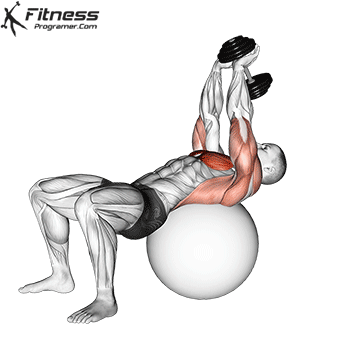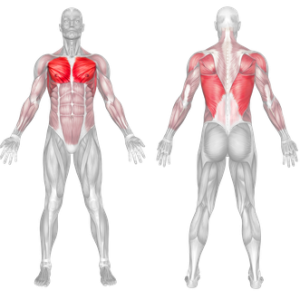Dumbbell Pullover On Stability Ball Overview
The dumbbell pullover is a strength exercise that primarily targets the chest and latissimus dorsi (lats). By combining the stability ball with a classic pullover movement, you enhance muscle activation and improve functional strength. This exercise is particularly beneficial for those looking to build chest and back strength while improving balance and core engagement.
How to Perform:

Setup:
- Select a moderate-weight dumbbell that allows controlled movement.
- Sit on a stability ball and slowly walk your feet forward until your upper back and shoulders are supported, with your hips lifted into a bridge position.
- Hold the dumbbell with both hands, positioning it directly above your chest with arms extended.
Execution:
- Keep a slight bend in your elbows as you slowly lower the dumbbell behind your head in a controlled motion.
- Lower the weight until your arms are aligned with your ears or you feel a comfortable stretch in your chest and lats.
- Engage your chest and back muscles to bring the dumbbell back to the starting position.
- Repeat for 10–15 reps, maintaining proper control and breathing throughout.
Tips for Proper Form
- Keep your hips lifted in a bridge position to maintain core activation.
- Avoid excessive bending of the elbows to ensure the movement remains a pullover and not a triceps extension.
- Move through a full range of motion, but avoid lowering the dumbbell too far to prevent unnecessary shoulder strain.
- Keep a neutral spine and engage your core for stability.
- Control the weight throughout the movement to prevent momentum from taking over.
Common Mistakes to Avoid
- Using too much weight: This can compromise form and lead to injury.
- Letting the hips drop: This reduces core engagement and stability.
- Rushing the movement: A slow, controlled pace ensures proper muscle activation.
- Overextending the shoulders: Going too far back can put unnecessary stress on the joints.
Benefits of the Dumbbell Pullover on a Stability Ball
1. Targets Multiple Muscles
The dumbbell pullover is one of the few exercises that engage both the front and back of the upper body simultaneously. This movement primarily works the pectoralis major (chest) and latissimus dorsi (lats) while also activating the triceps, shoulders, and core. The stability ball further increases muscle activation by requiring greater core engagement to maintain balance.
2. Increases Chest Size and Strength
By stretching and contracting the chest muscles through a full range of motion, the dumbbell pullover enhances muscle fiber recruitment, which promotes muscle growth and definition in the pectoral muscles. This makes it an excellent exercise for those looking to develop a fuller, more powerful chest. Additionally, it can complement pressing movements like the bench press and push-ups.
3. Enhances Back Development
The dumbbell pullover strengthens the latissimus dorsi, contributing to a broader, more defined upper back. This helps improve upper body strength and enhances performance in pulling exercises such as pull-ups and rows. Strengthening the lats also contributes to a more powerful and athletic physique.
4. Improves Core Stability and Balance
Performing this exercise on a stability ball instead of a bench requires greater core activation to maintain balance. Your abdominals, obliques, and lower back work together to stabilize your body, making it an effective functional training exercise for improving core strength and balance.
5. Supports Better Posture and Mobility
The dumbbell pullover helps stretch tight chest and shoulder muscles, reducing forward shoulder posture and improving thoracic spine mobility. This is especially beneficial for individuals who spend long hours sitting, as it counteracts poor posture by opening up the chest and improving spinal extension. Increased shoulder mobility also reduces the risk of shoulder impingements and enhances movement efficiency in other exercises.
How to Incorporate Into Your Routine
- As a Chest & Back Exercise: Perform 3–4 sets of 10–15 reps on upper body strength days.
- As a Core Activation Exercise: Use lighter weight and higher reps for increased stability training.
- As Part of a Full-Body Workout: Combine with push-ups, rows, and deadlifts for a balanced workout.
- As a Warm-Up or Cool-Down: Perform with lighter weight to increase mobility before or after workouts.
Muscles Worked


